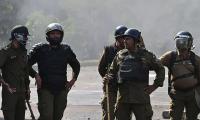KAMLOOPS, Canada: It is a lifetime since she left, but Evelyn Camille’s throat tightens as she returns to her old indigenous boarding school in western Canada to honour the 215 pupils whose bodies were discovered in a mass grave.
“Many children tried to run away from here,” she recalls, the memories of abuse rushing back as she surveys its red brick facade.
Camille has gathered with family and friends at the site in British Columbia to commemorate the “many who never made it home.”
Now a tribal elder who teaches the children of her native community its language and customs, Camille was forced to attend the school as a girl in the 1940s.
Camille was separated from her family and sent tens of kilometers to the Kamloops Indian Residential School.
She would spend 10 years at the largest of 139 such schools set up a century ago to assimilate Canada’s indigenous peoples.
“They came and took us in big cattle trucks,” she said in an interview with AFP. “They picked us up from our reserves and brought us here.”
As she speaks, her throat tightens. Memories of the school horrors come flooding back. “We were physically, mentally, spiritually abused,” Camille says, holding back tears.
Just talking about it, she says, “is really upsetting.”
“So many of these deaths have never been accounted for,” she adds.
Some 150,000 Indian, Inuit and Metis children in total were enrolled in these residential schools, where students were physically and sexually abused by headmasters and teachers who stripped them of their culture and language.
At least 4,100 students died from disease, malnutrition or neglect, according to a truth and reconciliation commission that in 2015 called it “cultural genocide.”
Today, those experiences are blamed for a high incidence of poverty, alcoholism and domestic violence, as well as high suicide rates, in indigenous communities.
Canada has been convulsed by the discovery of the remains in Kamloops — especially as there were only 50 deaths officially on record here. The valley was first explored by European fur traders in the early 1800s, but has been home for centuries to the Tk’emlupsemc.
A boy, 5, stands on the cracked ground of the Boqueirao reservoir in the Metropolitan Region of Campina Grande,...
Afghan female students walk near Kabul University in Kabul, Afghanistan, December 21, 2022. — ReutersGENEVA: Women...
People on India's eastern coast are fleeing to storm shelters before Cyclone Dana makes landfall. —AFP/fileBALASORE,...
Canadian Prime Minister Justin Trudeau.— AFP/FileOTTAWA: Canada said on Thursday it was significantly curbing...
Security personnel stand guard in front of the Bangabhaban, the residence and workplace of President Mohammed...
A man smokes a disposable vape. — Reuters/FileLONDON: Disposable vapes will be banned in the UK next year to protect...







